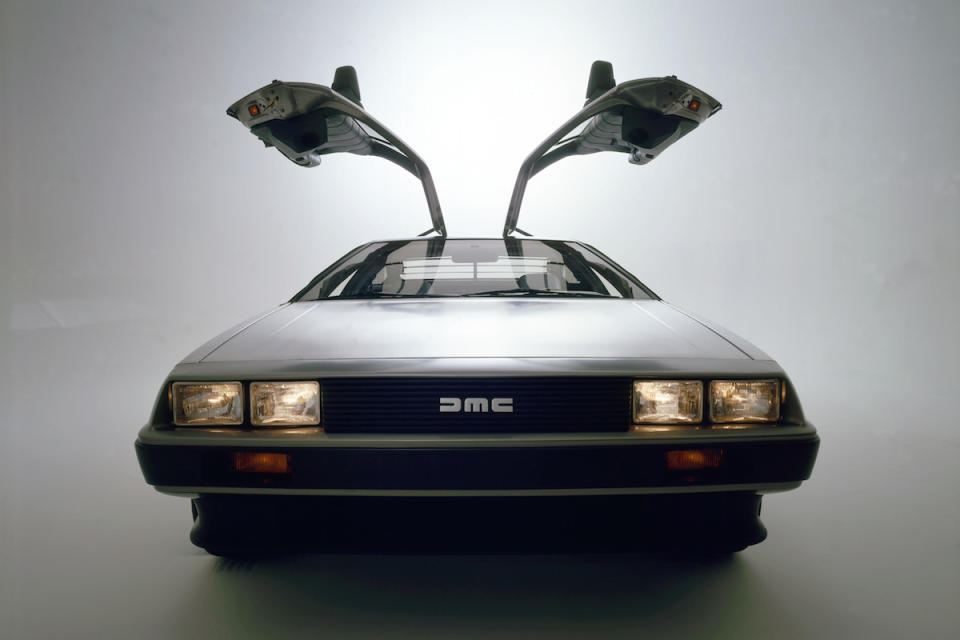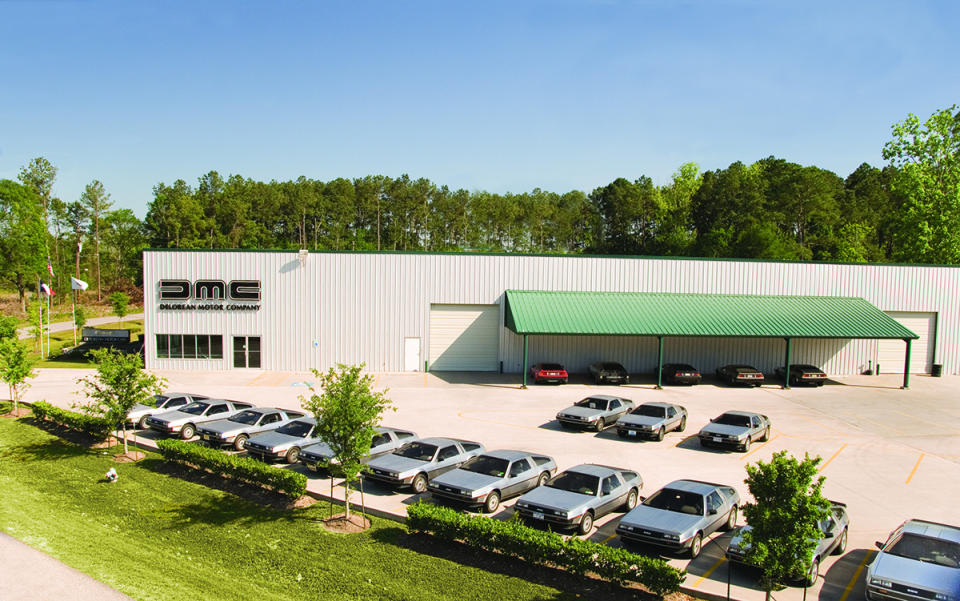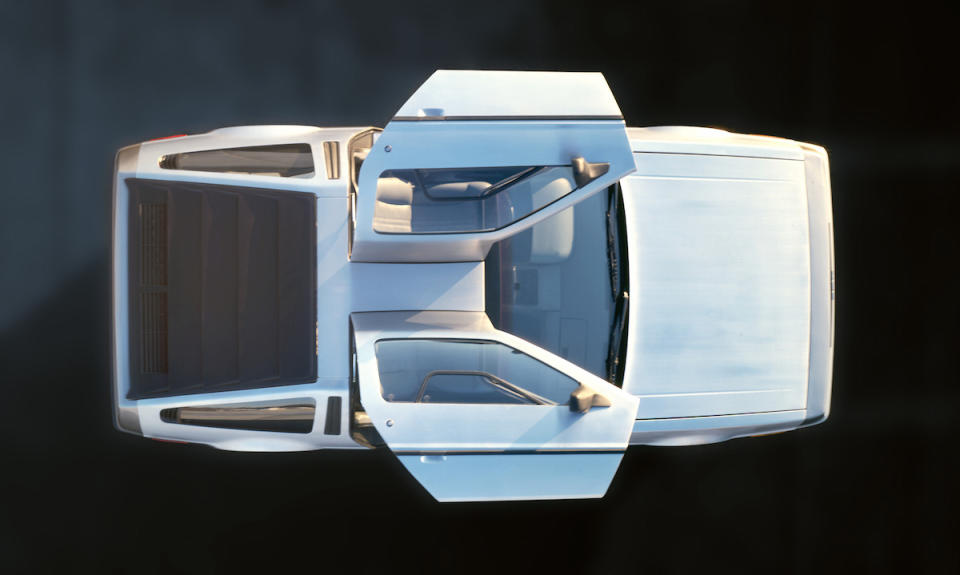The DeLorean Lives On, Back In This Future

In 1985, a movie came out showcasing a hot actor and a cool car. Michael J. Fox crushed the role of “Back To The Future” protagonist Marty McFly, and in the movie-trilogy-process immortalized the DeLorean DMC-12, a stainless steel, gull-winged automotive comet that burned bright and flamed out fast.
Or did it?
Thirty years after the first BTTF movie hit screens—its final moments featuring “Doc” Brown the mad scientist returning from the then impossibly distant date of October 21, 2015, aboard a flying DeLorean—the unmistakable sports car enjoys a second life thanks to a Texas company that has dedicated itself for decades to its preservation.
“There’s no question that the phone’s been ringing a lot more lately due to the anniversary year,” says James Espey, vice president of DeLorean Motor Company, which bought the original company’s name when it acquired the bulk of the factory’s parts and esoterica a few years after John Z. DeLorean’s dream died in 1982.
“We get people asking about renting a time machine,” says Espey, referring to DMC’s movie-version of the DeLorean, complete with glowing appendages and Mr. Fusion insta-energy maker strapped to the rear deck. “Some folks ask if we have the hovercraft conversion worked out. Well no, not yet.”
DMC, which is headquartered just outside Houston but has offices in five U.S. states, started as a small foreign car repair operation in Southern California. It began working on DeLoreans after former General Motors wunderkind exec DeLorean shuttered his cash-strapped venture on the heels of being caught in an FBI sting trying to sell cocaine.

DeLorean Motor Company headquarters
Although the dashing exec was later acquitted, the DeLorean automobile was instantly a part of history after a brief one-year production run that saw around 9,000 come to life.
By the mid-’90s, “most of the people with DeLorean parts wanted out,” says Espey, so he bought up whatever he could find, ranging from spare doors to detailed blueprints, and officially changed the company’s name to DMC. “Once we acquired the inventory, we became masters of our own destiny,” he says.
That said, DeLorean’s third wife, Sally, sued the Texas outfit earlier this year claiming it was illegally using the DMC name for the purpose of selling memorabilia and licensing the name to other companies.
The suit didn’t put a dent in DMC’s operations restoring cars and selling parts. To date, DMC has helped spruce up hundreds of the estimated 7,500 DeLoreans that remain. In fact, the suit has since been settled, says DMC’s attorney, William Mead of New Jersey law firm Litchfield Cavo.
Mead says far from being upset by a company that celebrates the short-lived vehicle, DeLorean himself had during his lifetime (he died in from a stroke at 80 in 2005) said “he was tickled by DMC carrying on the legacy of the vehicle. It just seemed odd to us that this many years later, this lawsuit would come up.”
Ask Espey about the suit and he simply responds that such arrows come with the territory when you’re dealing with a company that went into bankruptcy with creditors on its heels. “For years, we’d get calls from people saying we owed them money, but we had to explain weren’t that DMC, but a different company.”

There’s no doubt that Espey loves this oddly unique machine. While the business could easily just be an income-generating automotive niche, he prides himself on being “a student of the company’s history.”
To that end, beyond helping authors and researchers, he has made it his business to not only acquire hundreds of standard DeLorean parts - from windshields to steering racks - but also more esoteric but critical pieces including “all 13 molds for the fiberglass underbody which the stainless steel panels getting attached to.”
Espey says 60% of his business is parts, 30% is service and restoration and about 10% entire cars, often ground-up restorations. “We get a lot of calls from people saying, ‘My grandpa died and this car’s been in his garage for 20 years, can you fix it or buy it?’” says Espey.
So, you say you want a new DeLorean that was actually a bit better than what the company’s Irish factory produced? No problem. For around $65,000 and over the course of about three months, the DMC team will reconstruct a DMC-12 that feature a raft of improvements.
“Let’s see, the exterior door handles (for the gullwing doors) were plastic and didn’t last, we replace them with cast-zinc parts that look the same,” he says. “The factory alternator was underrated for modern technology toys like smartphones, and the power window motors, well those pieces had a 100% failure rate.”
When it comes to propulsion, the DeLorean in the “Back To The Future” movies looks the part of a racy machine. But there are a few giveaways that the vehicle was a bit of a dog. Foremost is the simple fact that in order to turn into a time machine, the car had to hit the blistering speed of … 88 miles per hour. The DMC-12’s speedo didn’t even show 100 mph.
“The factory used 2.8-liter V6s from Peugeot, Renault and Volvo, and they were good for about 130 hp,” says Espey. “That may seem lame today, but remember a ‘Vette back then (early ‘80s) had 180 hp and was a lot heavier.“
DMC doesn’t advocate engine swaps, so instead they offer three stages of V6 massage, from simple headers and free flow cats to a supercharger option that yields 240 hp. “That’s nice in a car that’s only about 2,800 pounds,” he says.
But if the DeLorean car still doesn’t wow you, Espey says the man should.
“The cars got some bad press in the early days due to quality issues, but the accomplishment of completely engineering and sourcing a new car in a new factory in just a few years will never be matched again,” he says, citing only Elon Musk’s bold move in creating Tesla electric vehicles as being remotely comparable.
Espey is the first to admit, however, that were it not for “Back To The Future,” this conversation wouldn’t even be happening.
“Without those movies, the DeLorean would be no more remembered than a Bricklin, so yes, I’m very grateful to them,” he says laughing.
“I go to car shows, and kids today don’t really know what a GTO or Chevelle is, but they know the ‘Back To The Future’ car. What that means is that somewhere out there, new generations are always going to see the films and go, ‘What’s that?’ And maybe they’ll grow up, go online and see us and think, ‘I can get one.’ That’s why we’re here.”

 Yahoo Autos
Yahoo Autos 